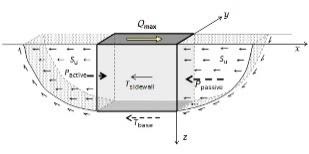Improved Design Methods
The building and construction sector accounts for almost 40% of global carbon emissions. Aiming to minimize the carbon footprint of geotechnical construction, we have been working towards the development of improved design and construction techniques.
Our work encompasses contributions in foundation design, including inclined piles and embedded foundations. Inclined piles are particularly useful when large lateral stiffness is required, as in the case of bridges subjected to seismic loading. However, a number of seismic failures have led to their avoidance or even prohibition by many seismic codes. As part of the EU-funded QUAKER research project, we investigated the seismic response of groups of inclined piles (external page J13, external page J23, external page J46), contributing to better understanding of failure mechanisms and the effect of the pilecap connection.
Our more recent work focused on the monotonic and cyclic response of embedded foundations. Employing 3D FE analysis, we have contributed to deeper understanding of the failure mechanisms and of the effect of the factor of safety on the combined bearing capacity, the cyclic response, and the elastic stiffness of embedded foundations in clay (external page J65). Combining centrifuge modelling (using our drum centrifuge) and numerical analysis, we explored the nonlinear response of embedded foundations in sand, from the initial quasi-elastic to the nonlinear regime (external page J81). We have derived extended formulas for the small-strain rocking stiffness, accounting for soil inhomogeneity and the effect of the factor of safety, and dimensionless degradation curves of the rocking stiffness with rotation. Our findings contribute to the development of improved, more rational, less conservative, and therefore more environmentally friendly foundation design.

Retaining structures constitute a major part of civil engineering construction, especially in metropolitan areas. Our work includes contributions related to static and seismic design of such systems, ranging from flexible anchored retaining walls (external page J2), to reinforced earth bar-mat walls (external page J30), to special retaining systems, such as the Opening Ceremony shaft for the Athens 2004 Olympic Games (external page J4). The latter case refers to a challenging consulting project, of major significance to the successful completion of the Olympic games. The excavation of the 25 m deep shaft had to be completed under extreme time constraints. Delays in starting the excavation necessitated that a depth of 17.5 m be reached before any permanent lining could be constructed. A detailed monitoring programme was implemented and utilised in the spirit of the observational method. Comparisons every two days of measured against original (class A), as well as updated, analytical predictions led to the successful completion of the project.

Selected recent publications

Taeseri D., Laue J., Anastasopoulos I. (2019). “Non-linear rocking stiffness of embedded foundations in sand”, Géotechnique, 69(9): 767-782 (external page J81).

Ntritsos N., Anastasopoulos I, Gazetas G. (2015). “Static and cyclic undrained response of square embedded foundations”, Géotechnique, 65(10): 805-823 (external page J65).